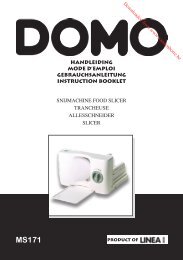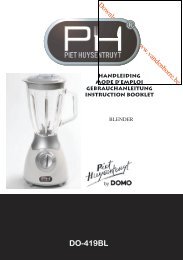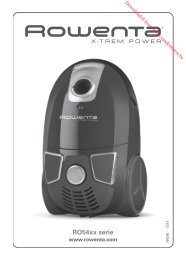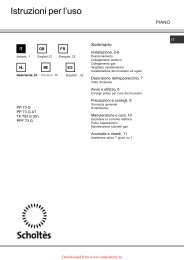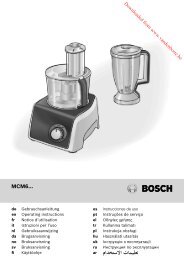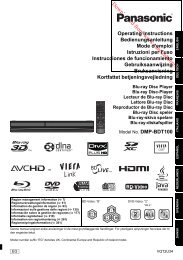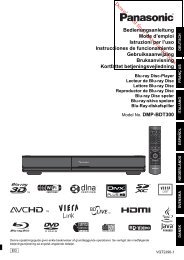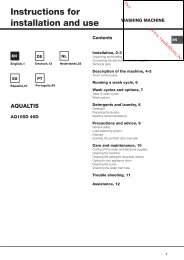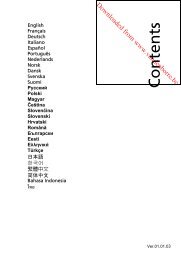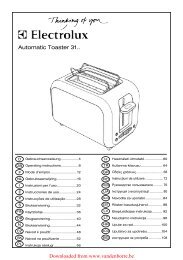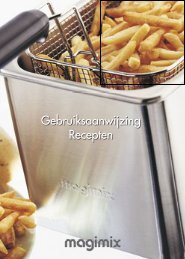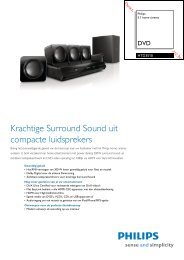Mise en page 1 - Vanden Borre
Mise en page 1 - Vanden Borre
Mise en page 1 - Vanden Borre
Create successful ePaper yourself
Turn your PDF publications into a flip-book with our unique Google optimized e-Paper software.
Downloaded from www.vand<strong>en</strong>borre.be<br />
Cut up fruit and vegetables that are too large to fit through the feed tubes.<br />
Never put fruit stones, excessively hard foods (ice cubes, sugar cubes), extremely fibrous foods, or<br />
meat into your juicer.<br />
Place one jug (N) under the spout (I) and the other jug (N) under the residue exit (K) to collect<br />
the pulp (fig. 8). Remember to empty the jug under the residue exit wh<strong>en</strong> it is full.<br />
Press the Start/Stop button (M) to turn on the appliance, place the food in the feed tubes (B) and<br />
push them down using the pusher (A). Make sure that the spout (I) is in the “low” position (juice<br />
flow).<br />
The fruit and vegetables must only be inserted while the motor is running.<br />
Never use your fingers or other ut<strong>en</strong>sils to push food through the spout.<br />
Do not press too hard on the pusher (A).<br />
Once the ingredi<strong>en</strong>ts have passed through, let the appliance turn for a few more seconds in order to<br />
obtain the maximum amount of juice.<br />
We recomm<strong>en</strong>d that you do not use the appliance continuously for over 20 minutes.<br />
After making your juice, activate the drip-stop system by pushing the spout up before removing the<br />
jug to stop the flow of the juice.<br />
If the juice contains froth, you can fit the foam separator accessory (O), onto the jug (N) which<br />
allows you to keep the froth inside the jug wh<strong>en</strong> you pour out the juice into a glass (fig. 9).<br />
Practical tips wh<strong>en</strong> choosing ingredi<strong>en</strong>ts:<br />
- Choose fruit and vegetables that are best for juicing such as oranges, apples, pears, pineapple,<br />
grapes, tomatoes, carrots, celery, cucumber, beetroot ....<br />
- It is difficult to extract juice from some fruit and vegetables such as bananas, avocados, aubergines<br />
and figs.<br />
- Wh<strong>en</strong> you press less juicy fruit (like bananas) and aromatic herbs, alternate with other juicy fruits<br />
or vegetables in order to facilitate extraction. Always finish with juicy fruit or vegetables.<br />
- Wh<strong>en</strong> you press long leaf herbs (such as wheatgrass), cut the leaves in 3 cm pieces in order to keep<br />
them from getting tangled around the pressing stem. Press a maximum of 400 g of herbs at a time.<br />
- Out of season, you can use froz<strong>en</strong> fruit. Let them thaw completely before pressing. You can also use<br />
fruit with syrup (lychees, peaches...).<br />
CLEANING<br />
Betwe<strong>en</strong> 2 preparations<br />
It is <strong>en</strong>ough to rinse the appliance without taking it apart by pouring water gradually into the feed<br />
funnel (B), with the appliance on. Make sure that you have placed an empty jug (N) under the juice<br />
exit. You can th<strong>en</strong> make one juice immediately after the other!<br />
After use<br />
Cleaning must be carried out immediately after use.<br />
Make sure that the appliance is disconnected.<br />
Never immerse the motor unit (L), power cord or plug in water or any other liquid.<br />
Do not put the motor unit (L) in the dishwasher.<br />
Take apart and clean all the removable parts: filters (D-E) (if necessary, use the brush (P)), residue<br />
strap (F) (inseparable from the filter but removable for cleaning purposes; if necessary, use the back<br />
<strong>en</strong>d of the brush (P)), bowl (G), juice collector (H) with spout with drip-stop (I).<br />
Make sure to clean the inside of the stem (C) carefully; if necessary, use the brush (P).<br />
11<br />
EN



